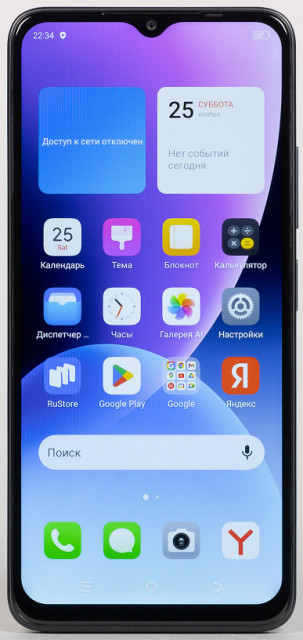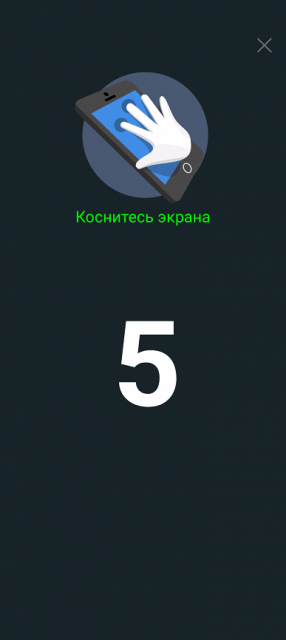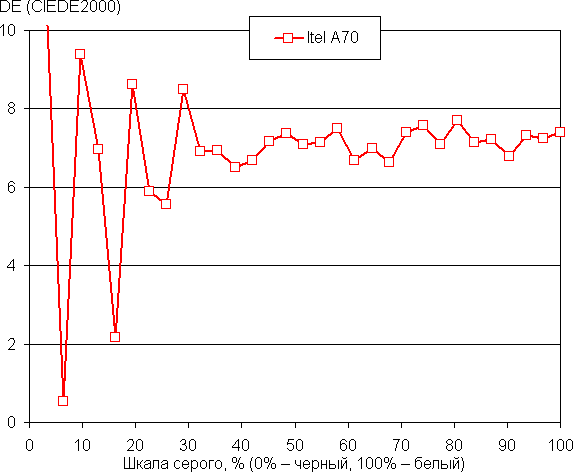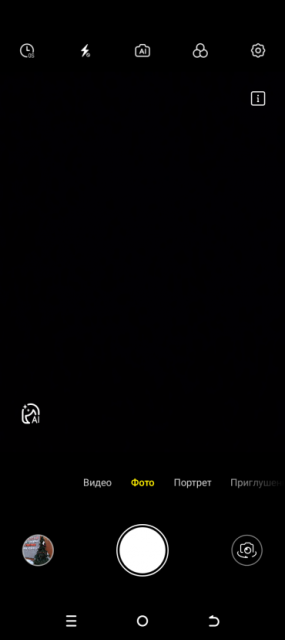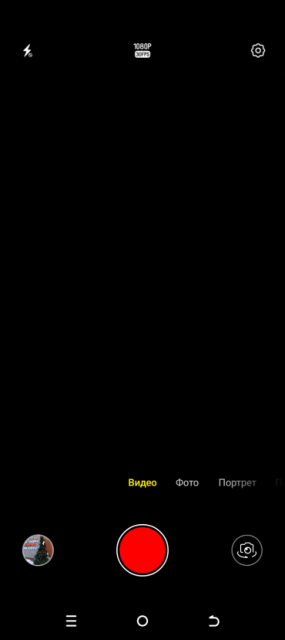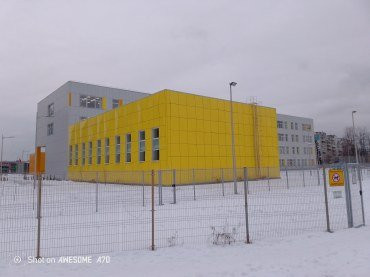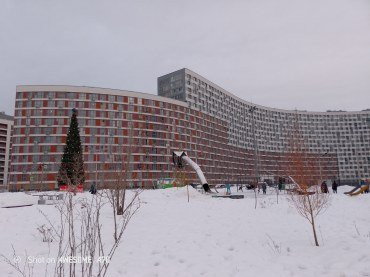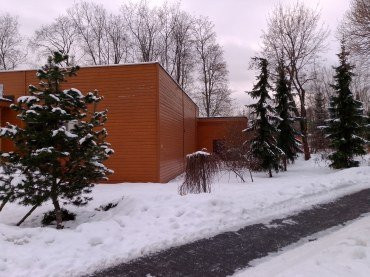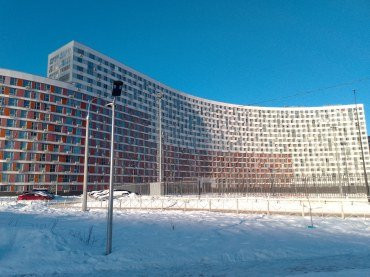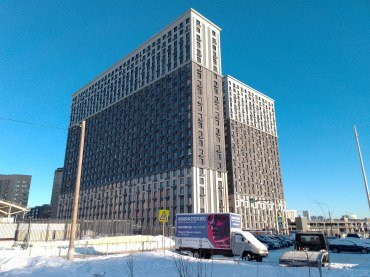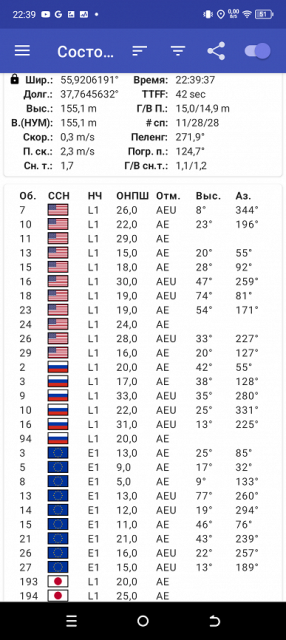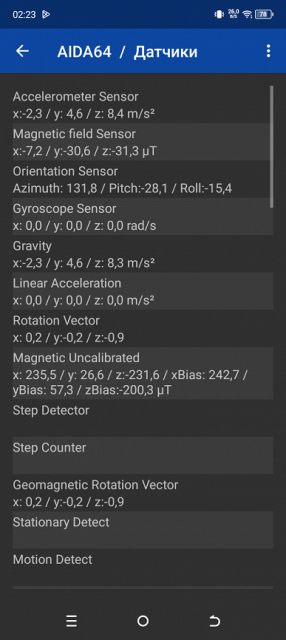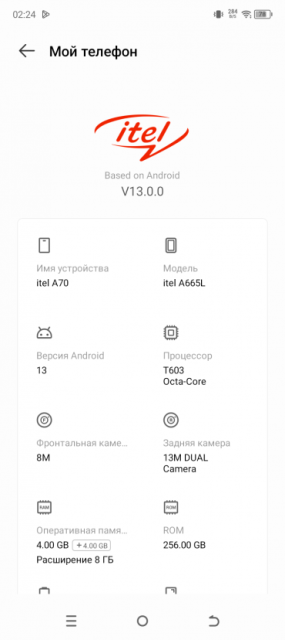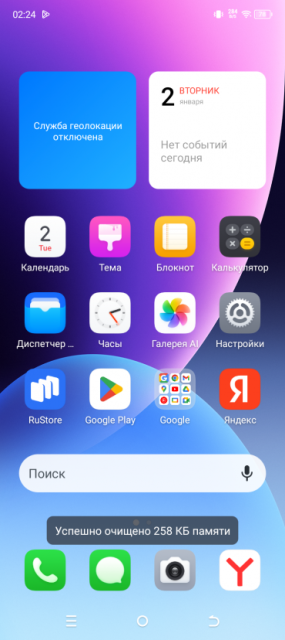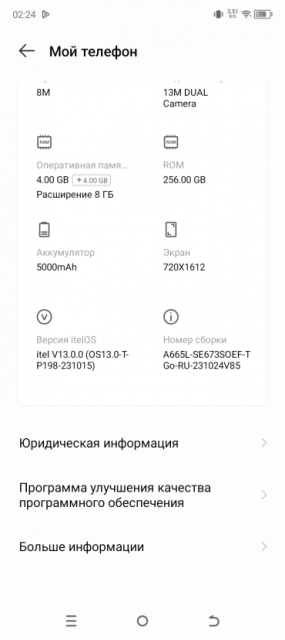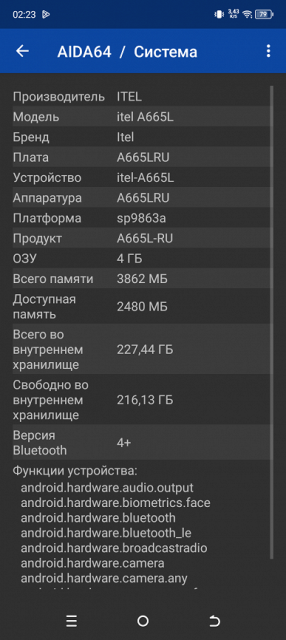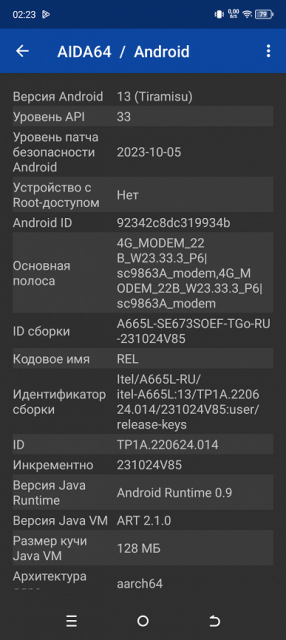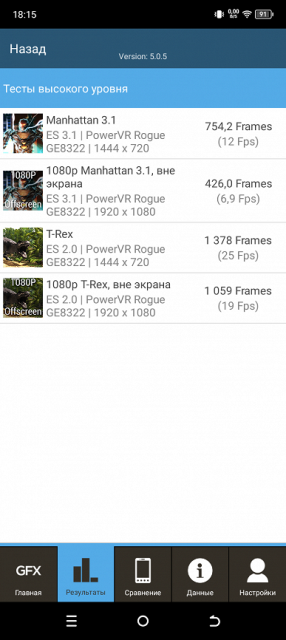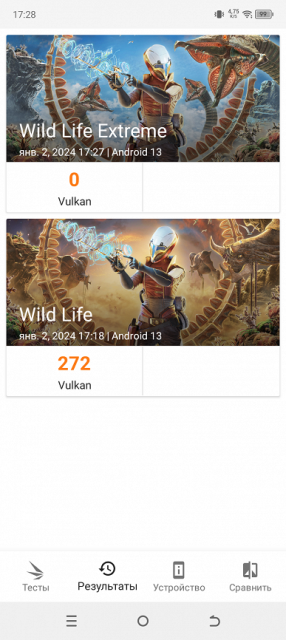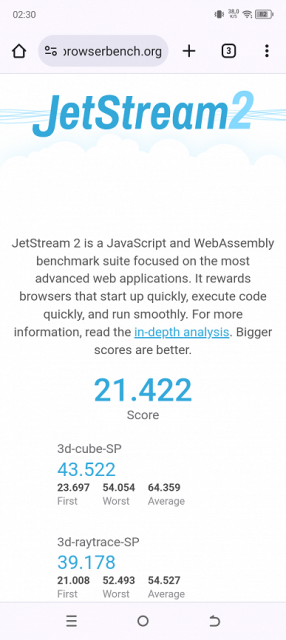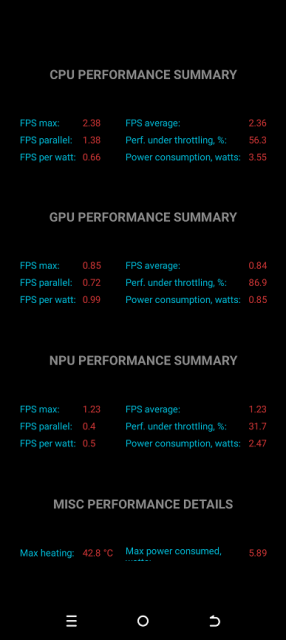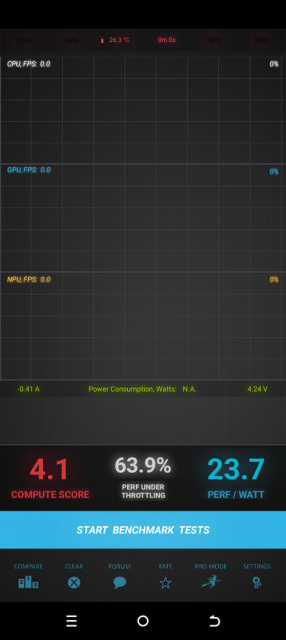The Itel A70 is a smartphone with a wide IPS display and a stylish design, but its key feature is its surprisingly low price. Let's take a look at where the savings were made to achieve such an affordable price, and whether this phone is even worth considering.

Main characteristics of Itel A70 (model A665L)
- SoC Unisoc T603, 8 processor cores (8×Cortex-A55 @1.8 GHz)
- GPU PowerVR GE8322
- Operating system Android 13
- Touch display IPS, 6.6″, 720×1612, 60 Hz, 20:9, 267 ppi
- RAM 3/4 GB, internal memory 128/256 GB
- microSD support (independent slot)
- Nano-SIM support (2 pcs.)
- Networks 2G GSM, 3G WCDMA, 4G
- GPS, Glonass, Galileo, BDS
- Wi-Fi 5 (2.4/5 GHz)
- Bluetooth 5.0
- USB 2.0 Type-C, USB OTG
- 3.5mm headphone audio output
- Cameras 13 MP + 0.08 MP, video 1080p@30 fps
- Front camera 8 MP
- Proximity and lighting sensors, magnetic field, accelerometer, gyroscope
- Fingerprint scanner (side-mounted)
- Battery 5000 mAh, charging 10 W
- Dimensions 164×75×8.6 mm
- Weight 186 g
Appearance and ease of use
Itel A70 comes in a cardboard box with a standard set of accessories.
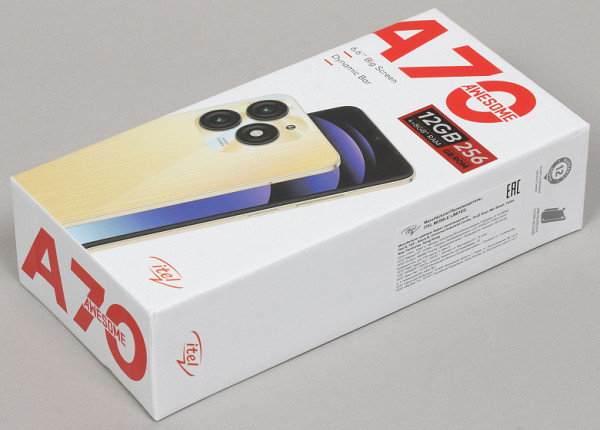
The smartphone comes with a charger with a maximum output power of 10 W, a connecting cable and a protective case.
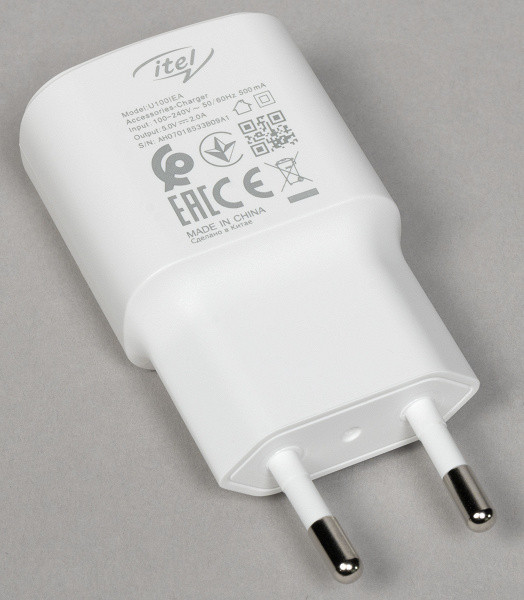
Despite its incredibly low cost, the smartphone has a modern and stylish appearance. The body is designed in accordance with the latest trends, with wide, flat sides and straight surfaces, without excessive narrowing on the sides or curved glass.
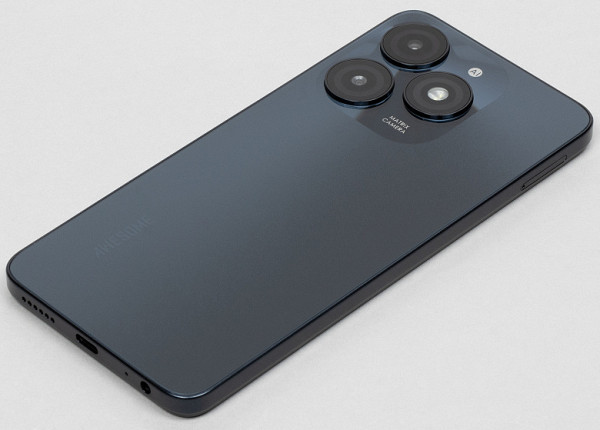
The body is made of plastic, but its appearance gives the impression that the back panel is made of frosted glass with a textured coating. This surface does not leave fingerprints, making the case practical and resistant to abrasions. The side frame is also made of matte plastic rather than metal.
In terms of dimensions, the device is standard, quite large, but not very heavy: the weight does not exceed 190 g. The transitions between the edges are not sharp, the edge does not cut into the skin of the palm.

The included silicone case is flexible, but not transparent. It is made in black and has a geometric pattern reminiscent of Apple's famous wireless magnetic charging.
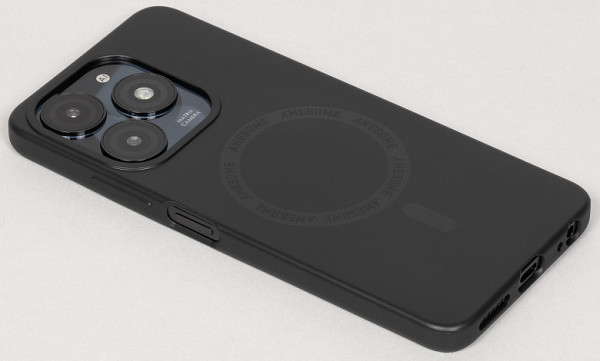
The cameras on the back are beautifully and symmetrically designed in the form of those same “burners”, again with a reference to the Apple iPhone. Another thing is that not every round piece of glass hides a full-fledged camera.
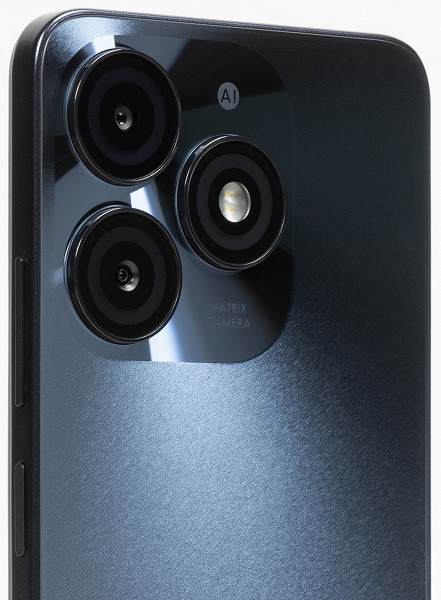
Both side buttons are located on the right, they are easy to touch. The fingerprint scanner in the power and lock buttons works flawlessly.

The front camera is presented in a single copy and is placed in a drop-shaped cutout of the screen — a characteristic feature of devices with a low budget. In most modern phones, the camera is integrated behind the notch in the matrix, which allows the “dead zone” on the screen to be reduced to a minimum.
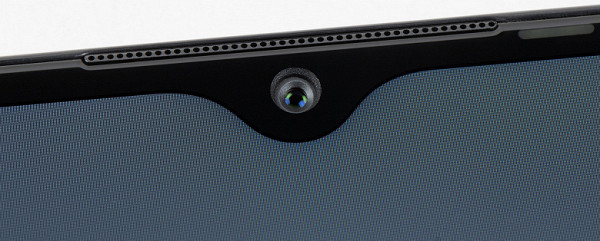
The retractable tray can accommodate three cards at once: two Nano-SIM and a microSD memory card.
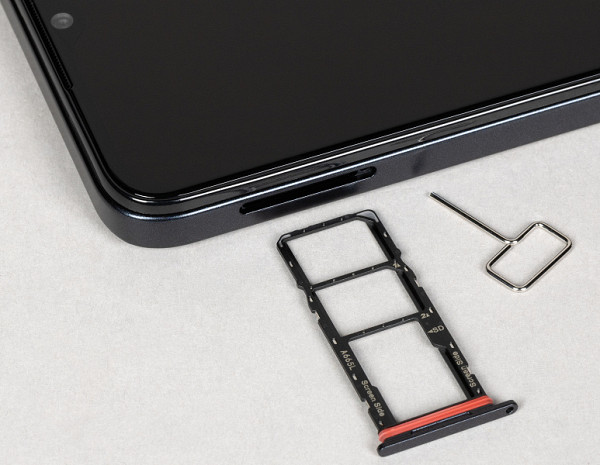
At the bottom end there is a speaker, a microphone, a USB Type-C connector and a 3.5 mm audio output.

There is nothing on the top end.

The smartphone body does not receive full protection from moisture and dust. The model is available in several colors — blue, black, gold, green.

Screen
The Itel A70 smartphone is equipped with a 6.6-inch IPS display with a resolution of 720x1612 pixels (with an aspect ratio of 20:9 and a pixel density of 267 ppi), protected by flat glass. The physical dimensions of the screen are 68x153 mm. The bezels around the screen are 3.5mm wide on the sides, 4mm at the top and 7mm at the bottom. The screen refresh rate does not exceed 60 Hz.
The front part of the screen is made in the form of a glass plate with a mirror-smooth surface that is scratch-resistant. Judging by the reflection of objects, the anti-glare properties of the screen are superior to the screen properties of the Google Nexus 7 (2013) (below, simply Nexus 7). The outer surface of the screen has a special oleophobic (grease-repellent) coating that is more effective than that of the Nexus 7, making fingerprints easier to remove and appear more slowly than with regular glass.
With manual brightness control and when the white field is displayed on the entire screen, the maximum brightness value is 390 cd/m². Although the maximum brightness is not the highest, excellent anti-glare properties allow you to use the smartphone even on a sunny day outside. The minimum brightness value is 3 cd/m², which allows you to comfortably control the brightness in complete darkness. There is no automatic brightness adjustment based on the light sensor. At any brightness level there is no significant backlight modulation, which eliminates screen flickering.
This smartphone uses an IPS type matrix. The micrographs show the typical subpixel structure for IPS.
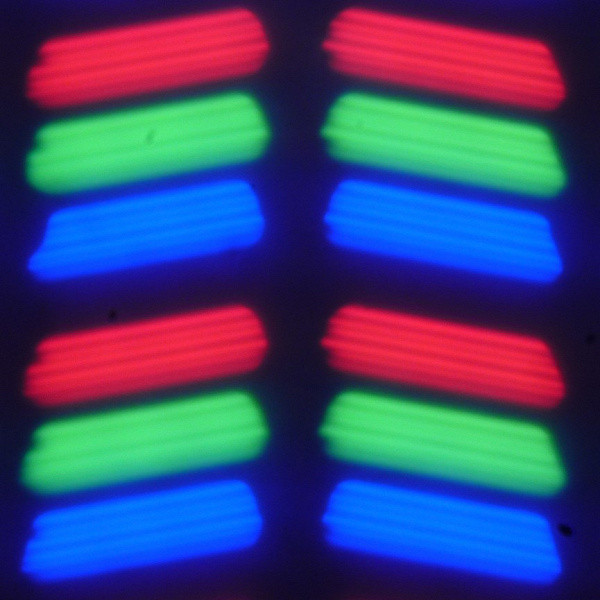
On a white background, the uniformity of brightness and color tone throughout the entire screen is characterized by a high level of quality. Let's provide an image in which the same images are displayed on the screens of a smartphone and a Nexus 7. In this case, the brightness of the screens is initially set to approximately 200 cd/m², and the color balance on the camera is actively set to 6500 K:
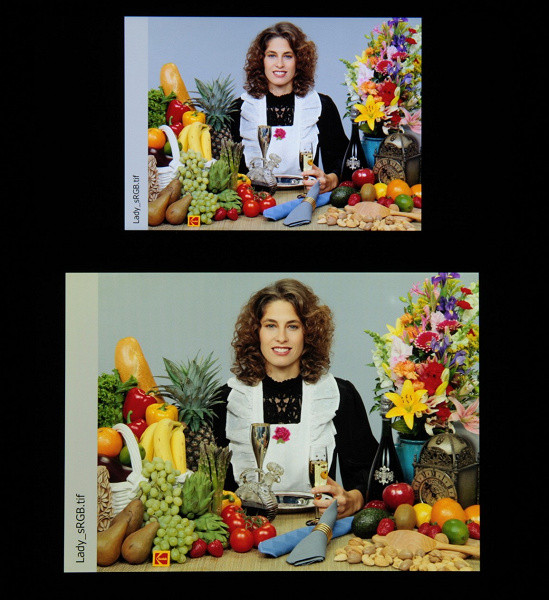
Colors on the smartphone screen look natural with near-realistic saturation, while the color balance between the Nexus 7 and our test screens is noticeably different.
The smartphone screen provides good viewing angles without significant color changes, even at large viewing angles relative to the perpendicular to the screen, and without inversion of shades. However, with a diagonal deviation, the black field is strongly highlighted and acquires a red-violet hue.
When looking directly at the screen, the uniformity of the black field is assessed as average:

The screen contrast (approximately in the center) reaches a high level of approximately 1500:1. The response time from black to white and back is 25 ms (13 ms on + 12 ms off). The transition between halftones of gray at levels 25% and 75% (based on the numerical value of the color) and back takes a total of 40 ms.
The gamma curve, based on 32 points with equal intervals of numerical gray values, does not reveal distortion in light or dark areas. The power function fitting exponent is 2.24, slightly higher than the standard value of 2.2. However, the real gamma curve deviates little from the power law:

We did not detect the presence of dynamic adjustment of the backlight brightness in accordance with the nature of the displayed image, which is very good.
Color gamut is close to sRGB:
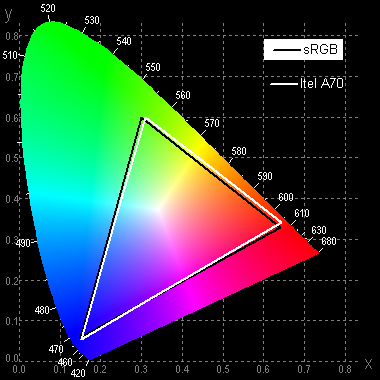
The spectra show that the matrix filters moderately mix the components with each other:
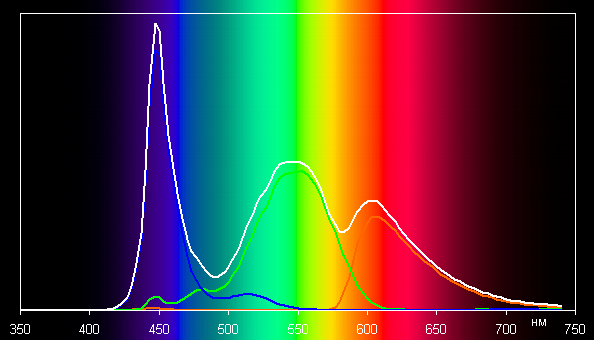
Initially, the balance of shades on the gray scale is in the compromise zone, since the color temperature significantly exceeds the standard 6500 K and is 9500 K on a white background. However, a setting is available that allows you to reduce the intensity of the blue component, which helps correct this shortcoming.

In general, intense light can affect the circadian rhythm (see article on iPad Pro 9.7-inch display). However, this effect is easily compensated for by reducing the brightness to a low, but still comfortable level. Avoiding color balance distortions by reducing the blue component is absolutely pointless. This setting is provided to correct the color balance, and the result after manual correction (similar to the slider as in the previous photo) is satisfactory. The color temperature gets fairly close to the standard 6500K, and the blackbody deviation (ΔE) remains below 10, which is considered acceptable for a consumer device. In addition, color temperature and ΔE vary little from shade to shade, which has a beneficial effect on the visual assessment of color balance. (The darkest areas of the gray scale can be ignored because color balance is not very important there, and the error in measuring color characteristics at low brightness is large.)
This unit probably does not support DisplayPort Alt Mode for USB Type-C, which means that it is not possible to output image and sound to an external device when connected to a USB port.
To summarize: the screen has a low maximum brightness (390 cd/m²), but has excellent anti-glare properties, which probably allows you to use the device even outdoors on a bright sunny day. In complete darkness, the brightness can be reduced to a comfortable level (up to 3 cd/m²). Among the advantages of the screen are an effective oleophobic coating, no air gap in the layers of the screen, no visible flicker, high contrast (1500:1), color gamut close to sRGB and good color balance after correction. Disadvantages include reduced resolution and limited black stability when looking away from perpendicular to the screen. In general, given the importance of characteristics for this class of devices, the quality of the screen can be assessed as not high.
Camera
The Itel A70 smartphone is equipped with three large symmetrical glass windows on the back side, but in fact only one camera is installed — with a 13-megapixel sensor and an f/1.8 lens. Autofocus with phase detection PDAF is built-in, but there is no image stabilization.
The camera in this device is the basic level. The frames are characterized by the presence of unclear areas and noticeable noise artifacts, the overall detail is extremely low, and the image is unclear. There are comments on brightness and dynamic range. Color reproduction is also subject to distortion. And all this with a resolution of only 13 megapixels!
By the way, night photography against the background of daylight looks very good; honest noise is always preferable to such an attempt to suppress them, as in daytime photographs.
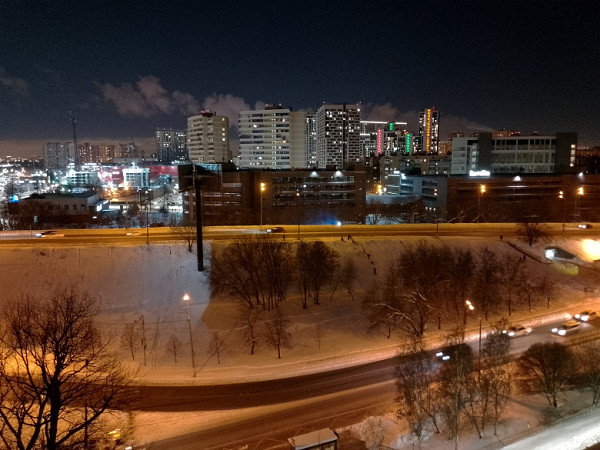
The front camera takes acceptable photos, although it doesn't provide nice background blur for portraits. However, the color reproduction of this camera is also subject to distortion, and there is a red shift.

The smartphone is capable of recording video in a maximum resolution of 1080p at 30 frames per second without stabilization. The image is bright but unstable, and its quality is marred by the lack of stabilization and image shake. In addition, the sound recorded is muffled.
Telephone and communications
The Itel A70 smartphone provides support for mobile networks up to 4G, without 5G support. In the urban area of the Moscow region, the device demonstrates reliable operation in wireless networks, does not lose connection and quickly restores it after temporary interruptions.
The smartphone also has a wireless adapter supporting Wi-Fi 5 (802.11a/b/g/n/ac, 2.4/5 GHz) and Bluetooth 5.0. However, there is no NFC support.
The single-channel satellite navigation module interacts with GPS, Glonass, Galileo and BDS. During a cold start, detecting the first satellites takes some time.
The voice of the interlocutor in the speaker is not too loud, but quite intelligible. Medium power vibration motor. The device has all the necessary built-in sensors, including a gyroscope.
Software and multimedia
The Itel A70 smartphone runs on the Android 13 operating system with its own shell. The interface is standard for Chinese devices with a good translation into Russian. In general, there are a small number of pre-installed apps that can be removed, and a limited amount of advertising, mostly related to the device's own services. The top curtain is divided into two parts depending on where it is pulled back. Official access to the Google store and applications is available.
The smartphone is not equipped with stereo speakers. The sound from the single speaker is quite loud and clear. However, aptX and aptX HD protocols are not supported for wireless headphones; only LDAC and AAC are available. There is also an audio output for wired headphones.
Performance
The Itel A70 smartphone is equipped with an octa-core Unisoc T603 SoC processor, paired with a PowerVR GE8322 GPU graphics accelerator. RAM is available in 3 or 4 GB options. The built-in memory can be 128 or 256 GB, and the use of a memory card is also supported. The device is equipped with a USB Type-C port with the ability to connect external devices in USB OTG mode.
Although the platform's performance is at the entry level, the device receives less than 150 thousand points in the AnTuTu test. However, these characteristics are quite sufficient for smooth operation of the system.
Testing in comprehensive tests AnTuTu and GeekBench:
All results obtained during testing of the smartphone using the latest versions of popular benchmarks were systematized in tables for ease of analysis. Typically, the table includes the results of several other devices from different segments, also tested on the latest versions of the benchmarks. This is done for a visual comparison of numerical indicators. Unfortunately, within the framework of one comparison it is impossible to present results from different versions of benchmarks, so many worthy and relevant models that have been tested on previous versions of test programs are not taken into account.
| Itel A70 (Unisoc T603) | Tecno Camon 20 Premier 5G (Mediatek Dimensity 8050) | Vivo V27 (Mediatek Dimensity 7200) | Poco X5 Pro 5G (Qualcomm Snapdragon 778G) | Tecno Pova 5 Pro (Mediatek Dimensity 6080) | |
|---|---|---|---|---|---|
| AnTuTu (v9.x) (bigger is better) | 127877 | 683485 | 602528 | 536193 | 397188 |
| GeekBench 6 (bigger is better) | 211/845 | 1097/3097 | 1198/2686 | 941/2640 | 759/2053 |
Testing the graphics subsystem in 3DMark and GFXBenchmark gaming tests:
| Itel A70 (Unisoc T603) | Tecno Camon 20 Premier 5G (Mediatek Dimensity 8050) | Vivo V27 (Mediatek Dimensity 7200) | Poco X5 Pro 5G (Qualcomm Snapdragon 778G) | Tecno Pova 5 Pro (Mediatek Dimensity 6080) | |
|---|---|---|---|---|---|
| 3DMark Wild Life Extreme Vulkan (bigger is better) | — | 1293 | 1165 | 687 | 368 |
| 3DMark Wild Life Vulkan (bigger is better) | 272 | 4505 | 4186 | 2450 | 1327 |
| GFXBenchmark Manhattan ES 3.1 (Onscreen, fps) | 12 | 78 | 59 | 49 | 24 |
| GFXBenchmark Manhattan ES 3.1 (1080p Offscreen, fps) | 7 | 91 | 68 | 56 | 28 |
| GFXBenchmark T-Rex (Onscreen, fps) | 25 | 120 | 110 | 109 | 59 |
| GFXBenchmark T-Rex (1080p Offscreen, fps) | 19 | 212 | 160 | 132 | 69 |
Testing in browser cross-platform tests:
| Itel A70 (Unisoc T603) | Tecno Camon 20 Premier 5G (Mediatek Dimensity 8050) | Vivo V27 (Mediatek Dimensity 7200) | Poco X5 Pro 5G (Qualcomm Snapdragon 778G) | Tecno Pova 5 Pro (Mediatek Dimensity 6080) | |
|---|---|---|---|---|---|
| Google Octane 2 (bigger is better) | 4982 | 27796 | 29329 | 27070 | 19194 |
| JetStream (bigger is better) | 21 | 60 | 87 | 73 | 50 |
AndroBench memory speed test results:

Heat
We test for performance degradation when heated using the Burnout Benchmark program, which allows you to load the CPU, GPU and NPU:
| Stress on | Heating performance as a percentage of maximum |
|---|---|
| CPU | 56% |
| GPU | 87% |
| NPU | 32% |
Battery life
The Itel A70 smartphone is equipped with a battery with a typical capacity of 5000 mAh for current standards. The autonomy of the device is satisfactory, but does not go beyond this level.
During testing, normal power consumption was used without activating power saving features, although such options are present in the device. Test conditions included a minimum comfortable brightness level (approximately 100 cd/m²). Tests included continuous reading in the Moon+ Reader app using the standard light theme, continuous HD video playback (720p) over home Wi-Fi, and Injustice 2 with automatic graphics settings.
| Battery capacity | Reading mode | Video mode | 3D Game Mode | |
|---|---|---|---|---|
| Itel A70 | 5000 mAh | 17:30 | 15:00 | 7:00 am |
| Tecno Spark 20 | 5000 mAh | 19:00 | 16:30 | 8:00 am |
| Tecno Pova 5 Pro | 5000 mAh | 20:00 | 13:30 | 7:00 am |
| Tecno Pova 5 Free Fire | 6000 mAh | 22:30 | 16:30 | 7:30 a.m. |
| Tecno Camon 20 Premier 5G | 5000 mAh | 25:00 | 19:00 | 7:00 am |
| Vivo V27 | 4600 mAh | 25:00 | 19:00 | 7:00 am |
| Poco X5 Pro 5G | 5000 mAh | 18:00 | 20:00 | 7:00 am |
| Realme 10 Pro+ 5G | 5000 mAh | 19:00 | 18:00 | 5:00 a.m. |
All figures provided represent the maximum possible values obtained under «ideal» conditions, including no SIM cards installed. Any changes to the use case will likely result in worse results.
Using the standard 10W wall charger included in the box, the smartphone is fully charged within three hours. Wireless charging is not supported on this device.
Bottom line
The Itel A70 smartphone is currently available at prices starting from 6 thousand rubles. For this amount, the buyer receives a device with a pleasant external design that remains relevant today. However, most other specs leave a lot to be desired, including an inefficient processor, a low-resolution screen, and an outdated waterdrop notch. The camera also exhibits weak results, but there are several positive features, such as the presence of a mini-jack and a slot for a microSD card, which is typical for modern budget smartphones.


